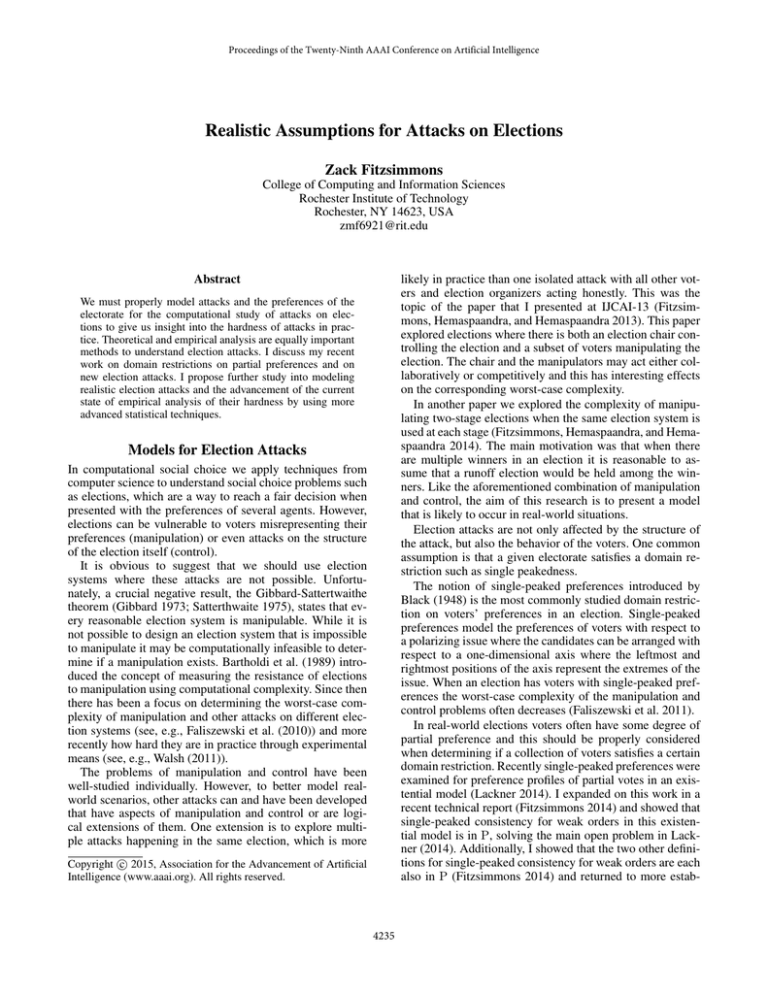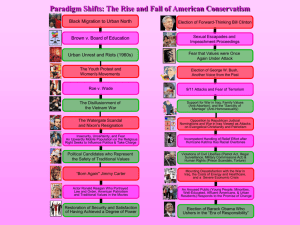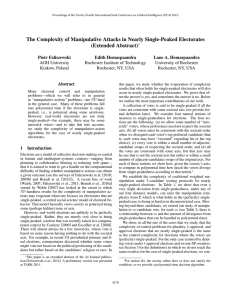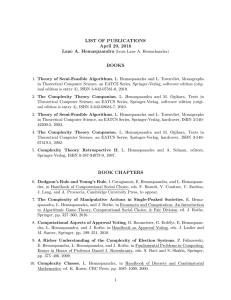
Proceedings of the Twenty-Ninth AAAI Conference on Artificial Intelligence
Realistic Assumptions for Attacks on Elections
Zack Fitzsimmons
College of Computing and Information Sciences
Rochester Institute of Technology
Rochester, NY 14623, USA
zmf6921@rit.edu
Abstract
likely in practice than one isolated attack with all other voters and election organizers acting honestly. This was the
topic of the paper that I presented at IJCAI-13 (Fitzsimmons, Hemaspaandra, and Hemaspaandra 2013). This paper
explored elections where there is both an election chair controlling the election and a subset of voters manipulating the
election. The chair and the manipulators may act either collaboratively or competitively and this has interesting effects
on the corresponding worst-case complexity.
In another paper we explored the complexity of manipulating two-stage elections when the same election system is
used at each stage (Fitzsimmons, Hemaspaandra, and Hemaspaandra 2014). The main motivation was that when there
are multiple winners in an election it is reasonable to assume that a runoff election would be held among the winners. Like the aforementioned combination of manipulation
and control, the aim of this research is to present a model
that is likely to occur in real-world situations.
Election attacks are not only affected by the structure of
the attack, but also the behavior of the voters. One common
assumption is that a given electorate satisfies a domain restriction such as single peakedness.
The notion of single-peaked preferences introduced by
Black (1948) is the most commonly studied domain restriction on voters’ preferences in an election. Single-peaked
preferences model the preferences of voters with respect to
a polarizing issue where the candidates can be arranged with
respect to a one-dimensional axis where the leftmost and
rightmost positions of the axis represent the extremes of the
issue. When an election has voters with single-peaked preferences the worst-case complexity of the manipulation and
control problems often decreases (Faliszewski et al. 2011).
In real-world elections voters often have some degree of
partial preference and this should be properly considered
when determining if a collection of voters satisfies a certain
domain restriction. Recently single-peaked preferences were
examined for preference profiles of partial votes in an existential model (Lackner 2014). I expanded on this work in a
recent technical report (Fitzsimmons 2014) and showed that
single-peaked consistency for weak orders in this existential model is in P, solving the main open problem in Lackner (2014). Additionally, I showed that the two other definitions for single-peaked consistency for weak orders are each
also in P (Fitzsimmons 2014) and returned to more estab-
We must properly model attacks and the preferences of the
electorate for the computational study of attacks on elections to give us insight into the hardness of attacks in practice. Theoretical and empirical analysis are equally important
methods to understand election attacks. I discuss my recent
work on domain restrictions on partial preferences and on
new election attacks. I propose further study into modeling
realistic election attacks and the advancement of the current
state of empirical analysis of their hardness by using more
advanced statistical techniques.
Models for Election Attacks
In computational social choice we apply techniques from
computer science to understand social choice problems such
as elections, which are a way to reach a fair decision when
presented with the preferences of several agents. However,
elections can be vulnerable to voters misrepresenting their
preferences (manipulation) or even attacks on the structure
of the election itself (control).
It is obvious to suggest that we should use election
systems where these attacks are not possible. Unfortunately, a crucial negative result, the Gibbard-Sattertwaithe
theorem (Gibbard 1973; Satterthwaite 1975), states that every reasonable election system is manipulable. While it is
not possible to design an election system that is impossible
to manipulate it may be computationally infeasible to determine if a manipulation exists. Bartholdi et al. (1989) introduced the concept of measuring the resistance of elections
to manipulation using computational complexity. Since then
there has been a focus on determining the worst-case complexity of manipulation and other attacks on different election systems (see, e.g., Faliszewski et al. (2010)) and more
recently how hard they are in practice through experimental
means (see, e.g., Walsh (2011)).
The problems of manipulation and control have been
well-studied individually. However, to better model realworld scenarios, other attacks can and have been developed
that have aspects of manipulation and control or are logical extensions of them. One extension is to explore multiple attacks happening in the same election, which is more
c 2015, Association for the Advancement of Artificial
Copyright Intelligence (www.aaai.org). All rights reserved.
4235
attacks on elections. I will analytically examine the effect of
voter distributions, models for preferences, and the relative
vulnerability that an election has to different attacks. New
variants of election attacks can each be applied to known
election systems or variants of these election systems to discover where each of these cases are computationally easy or
hard in the worst case and in practice.
Before AAAI-15 I intend on exploring partial singlepeakedness in the datasets containing partial votes found on
P REF L IB (Mattei and Walsh 2013) and expanding the computational study of domain restrictions from social choice
literature, focusing on partial preferences. Additionally, I intend on exploring new variants of election attacks both theoretically and empirically using the proposed methods.
The theoretical and empirical analysis of hard election
problems under realistic assumptions will advance our understanding of the in-practice hardness of attacks on elections and result in a better understanding of the conditions
that make these problems hard.
Acknowledgments: This work was supported in part by
NSF grant no. CCF-1101452 and the NSF Graduate Research Fellowship under NSF grant no. DGE-1102937.
lished models of single-peakedness for partial preferences.
The current models for manipulation, control, and assumptions on the structure of the preferences of the voters
in an election must be extended to better model real-world
scenarios, but must be within a reasonable scope to study.
Analysis of Election Attacks
Theoretical and empirical analysis of hard election problems
must both be done to better understand the worst-case and
in-practice hardness of attacks on elections.
Theoretical results are often either polynomial-time algorithms or proofs of NP-hardness, while a large proportion
of the empirical studies published in computational social
choice have similar design to the important early work by
Walsh (2011). Heuristic and/or approximation algorithms
are run a large number of times on votes sampled from different statistical cultures or from real-world data. Descriptive statistics are then gathered such as the average time required and the sample probability that manipulation is possible for different combinations of the voter distribution, the
size of the candidate and voters sets, and the number of
manipulators. Graphs are generated that illustrate general
trends and some conclusions are drawn. This experimental
approach fails to assess the significance of the predictor variables (e.g., voter distribution, size of the candidate and voter
sets) with respect to the response (either time required or
manipulation possible/not possible). If a more rigorous experimental design is used then stronger conclusions can be
made. For example, instead of being limited to stating that
the time required by a given algorithm increases in an experiment as the size of the candidate set increases, we would
be able to test if the size of the candidate set causes a statistically significant difference in the time required by the
algorithm in general.
We will expand on the current state of empirical analysis
of heuristic algorithms for different attacks on elections in
several ways. We will use experimental design techniques
such as analysis of variance (ANOVA) to determine which
values for our predictors results in a significant difference in
the time required by a given algorithm. In the case of interpreting the frequency that an attack is possible, we can use
multinomial regression models or other classification methods such as decision trees to fit the data.
These suggested techniques will result in better inference
into the behavior of a given algorithm when presented with
different inputs compared to simple descriptive statistics.
When the inputs are real-world data, or generated from reasonable assumptions, we gain inference into the in-practice
hardness and the frequency that a certain election attack is
possible.
References
Bartholdi, III, J.; Tovey, C.; and Trick, M. 1989. The computational difficulty of manipulating an election. Social Choice and
Welfare 6(3):227–241.
Black, D. 1948. On the rationale of group decision-making.
Journal of Political Economy 56(1):23–34.
Faliszewski, P.; Hemaspaandra, E.; Hemaspaandra, L. A.; and
Rothe, J. 2011. The shield that never was: Societies with singlepeaked preferences are more open to manipulation and control.
Information and Computation 209(2):89–107.
Faliszewski, P.; Hemaspaandra, E.; and Hemaspaandra, L. A.
2010. Using complexity to protect elections. Communications
of the ACM 53(11):74–82.
Fitzsimmons, Z.; Hemaspaandra, E.; and Hemaspaandra, L. A.
2013. Control in the presence of manipulators: Cooperative and
competitive cases. In Proc. of IJCAI-13, 113–119.
Fitzsimmons, Z.; Hemaspaandra, E.; and Hemaspaandra, L. A.
2014. X T HEN X: Manipulation of same-system runoff elections. Technical Report arXiv:1301.6118 [cs.GT], arXiv.org.
Fitzsimmons, Z. 2014. Single-peaked consistency for weak
orders is easy. Technical Report arXiv:1406.4829 [cs.GT],
arXiv.org.
Gibbard, A. 1973. Manipulation of voting schemes. Econometrica 41(4):587–601.
Lackner, M. 2014. Incomplete preferences in single-peaked
electorates. In Proc. of AAAI-14, 742–748.
Mattei, N., and Walsh, T. 2013. P REF L IB: A library for preferences. In Proc. of ADT-13, 259–270.
Satterthwaite, M. 1975. Strategy-proofness and Arrow’s conditions: Existence and correspondence theorems for voting procedures and social welfare functions. Journal of Economic Theory
10(2):187–217.
Walsh, T. 2011. Where are the hard manipulation problems?
JAIR 42(1):1–29.
Research Plan
I see worst-case complexity analysis and empirical analysis
of attacks on elections as two aspects that should be examined side-by-side for new and existing problems. I intend on
continuing to examine how statistical analysis applied to the
experimental study of elections could lead to a deeper understanding of what factors influence the in-practice hardness of
4236






